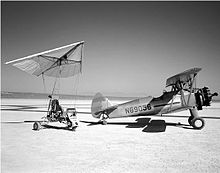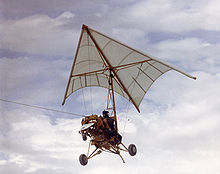- NASA Paresev
-
Paresev Paresev 1 in landing, 1962 Role Flexible-wing research glider Manufacturer NASA First flight 1962 The Paresev (Paraglider Research Vehicle) was an experimental NASA glider aircraft based upon the kite-parachute studies by NASA engineer Francis Rogallo.
Between 1961 and 1965 the ability of the Rogallo wing (also called "Parawing") to descend a payload such as the Gemini space capsule safely from high altitude to ground was studied.[1][2] The Paresev was a test vehicle used to learn how to control this parachute-wing for a safe landing at a normal airfield.
Publicity on the Paresev and the Ryan XV-8 "Flying Jeep" aircraft inspired hobbyists to adapt Rogallo's flexible wing airfoil onto elementary hang gliders leading to the most successful hang glider configuration in history.
Contents
Development
NASA experimented with the flexible Rogallo wing, which they renamed the Parawing, in order to evaluate it as a recovery system for the Gemini space capsules and recovery of used Saturn rocket stages.[3][4] Under a directive by Paul Bikle, NASA engineer Charles Richards in 1961–1962 designed the collapsible four-tube Rogallo wing used in the Paresev. The Paresev series included wing configurations that were tightly foldable from the nose plate for easy transport, using initially a cloth sail and later one of Dacron.
The Parasev sail and cross-spreader beam format first flown on February 5, 1961 was seen 14 months later in the April 1963 maiden flight of the Mike Burns Skiplane, as he had closely studied NASA literature[5]; Burns later helped make airworthy the ski-kite-glider of Australian John Dickenson that also embodied mechanics of the two-lobe four-beam wing designed earlier by Charles Richards.[6]
The Richards aluminum-tubed two-lobed Paresev wing configuration evolved to the sharp-nosed, low-sweep standard Rogallos of the 1960s and early 1970s, coupled with variations of the triangle control frame used in hang gliders as far back as the 1900s, if not earlier. Data developed by NASA in the late 1950s fed both the Charles Richards team and a different Ryan Aeronautical team that produced the Fleep. The Fleep used the four-beam two-lobed wing and influenced Barry Hill Palmer, builder and pilot of the first hang glider based on the Rogallo wing. The rigid-tubed Paresev used a cantilevered cross-beam but did not use a kingpost.[7]
Note that the "paraglider" involved in the early 1960s experiments is very different from the sport glider of today used by practitioners of paragliding.
Design and construction
The Paresev 1A and 1B were unpowered; the "fuselage" was an open framework fabricated of welded 4130 steel tubing, called a "space frame". The keel and leading edges of the wing were constructed of 2.5-inch-diameter (64 mm) aluminium tubing. The leading edge sweep[clarification needed] angle was held constant at 50 degrees by a rigid spreader bar. Additional wing structure fabricated from steel tubing ensured structural integrity.
The basic vehicle was slightly more than 11 ft (3.4 m) high from the top of the paraglider's wing to the ground, while the length of the center keel was 15 ft (4.6 m). Total weight was about 600 lb (270 kg)[8] On August 24, 1962, seven weeks after the project was initiated, the team rolled out the Paresev 1.[9]
Control
The Paresev was controlled by moving the tensionally hung pilot's and fuselage's mass relative to the position of the wing. This mass-shifting was effected by tilting the wing from side to side and fore and aft by using a control stick in front of the pilot that descended from the wing above. Another version translated the same weight-shift control via cables.[1] As the Paresev was towed in a kite mode, it usually rose from the ground at about 46 mph (74 km/h) and had a maximum air speed of about 65 mph (105 km/h). [10] The Paresev control pendulum weight-shift control system was presaged by a published patent[11], an early use of the hung pilot behind a cable-stayed triangle control bar in 1908[12] in the territory of Breslau, and then also by control wing of George Spratt in the 1920s.[13]
Variants
- Paresev 1 - first flight on January 25, 1962, crashed on March 14, 1962.[14] Frame fitted with a linen membrane wing and the control stick coming from overhead in front of the pilot's seat.
- Paresev 1A - first flight May 18, 1962, last flight was on June 28, 1962.[14] Used a rebuilt frame from the Paresev 1, but had a control stick and a Dacron membrane wing.
- Paresev 1B - first flight on July 27, 1962. Last flight on Feb 20, 1963.[14]
- Paresev 1C - first flight March 4, 1963. Last flight on April 14, 1964.[14] It had a modified frame with a half-scale version of an inflatable parawing.
Paresev flight log (NOTE – This log is incomplete*): Paresev Flight Log
* The Paresev vehicle was flown 341 times. Thompson made numerous ground-tow flights and claimed about 60 air-tow flights. Peterson claimed 228 flights (ground and air tows). Grissom made two flights. Champine made four flights. Kleuver made at least eight flights. It is unknown how many times Armstrong, Hetzel, and Slayton flew.
Operational history
The Paresev completed nearly 350 flights during a research program that ran from 1962 until 1964.[15][16] Using the fully flexible parawing or the tube-stiffened paraglider of the Paresev 1A, 1B, 1C as an alternate to spacecraft recovery was deemed too unreliable upon unfolding so round parachutes for water landings were used instead. The Paresev and other flexible-wing projects such as the Ryan XV-8 stopped being funded by NASA on 1965. Although Rogallo wrote about, modeled, and spoke about recreational applications including hang gliding, NASA was not in the business of applying Rogallo's family of airfoils to personal aircraft such as kites, hang gliders, and powered light aircraft.
The Paresev was transferred to the Smithsonian National Air and Space Museum located in Washington, D.C. for display.
Test pilots
- Milton Orville Thompson, NASA FRC
- Robert Apgar Champine, NASA LRC[17]
- Neil Armstrong, NASA FRC[18]
- Bruce A. Peterson, NASA FRC[19]
- Charles Hetzel, North American Aviation
- Maj. Emil “Jack” Kluever, U.S. Army
- Donald K. "Deke" Slayton, NASA MSC
- Virgil I. "Gus" Grissom, NASA MSC
Tow Aircraft
- Piper PA-18 Super Cub (N-68P)
- Cessna O-1 Bird Dog (50-1675)
- Stearman (N69056)
- Boeing HC-1A helicopter (58-5515)
Specifications
Data from[citation needed]
General characteristics
- Crew: One pilot
- Length: 15 ft 0 in (4.57 m)
- Height: 11 ft 0 in (3.35 m)
- Wing area: 179 ft2 (16.6 m2)
- Gross weight: 600 lb (270 kg)
Performance
- Maximum speed: 65 mph (100 km/h)
See also
- History of hang gliding
- Barry Hill Palmer, 1960–62
- Charles Richards (NASA engineer)
- Ultralight trike
References
- ^ a b Aviation News article[dead link]
- ^ Re-entry glider
- ^ Space Flight Revolution -article by NASA
- ^ In 1965 Jack Swigert, who would later be one of the Apollo 13 astronauts, softly landed a full-scale Gemini capsule using a Rogallo wing stiffened with inflatable tubes along the wing’s edges.
- ^ Sky Sport, pgs 39-43, 1989, article
- ^ http://www.dfrc.nasa.gov/gallery/photo/Paresev/index.html Paresev
- ^ A 33 page evaluation of two versions of the Paresev hang glider by "Preliminary Flight Evaluation of Two Unpowered Manned Paragliders" written by Barrison F. Layton, Jr., and Milton O. Thompson in National Aeronautics and Space Administration's Technical [vvvvvv Note D-1826] is open to the public and can be freely copied and distributed. Author(s): Layton, G. P., Jr.; Thompson, M. O.
- ^ Specifications
- ^ Construction & dated NASA images
- ^ Abstract: Flight tests of unpowered, manned paragliders. NASA Center: Dryden Flight Research Center Publication Year: 1963 Added to NTRS: 2006-11-06 Accession Number: 63N14429; Document ID: 19630004553; Report Number: NASA-TN-D-1826 NAS-TN-D-1826
- ^ http://www.google.com/patents?id=XQtXAAAAEBAJ U.S. Patent 376937, filed in 1887, William Beeson of Montana, USA
- ^ Nitsch Collection
- ^ Early Spratt Aircraft
- ^ a b c d Paresev index: Paresev Photo Gallery Contact Sheet
- ^ Total of 350 flights performed
- ^ Paresev project description
- ^ Apgar Champine, biography: Robert Apgar Champine
- ^ Neil Armstrong - Test flies the Paresev
- ^ Bruce Peterson
External links
- NASA Dryden Paresev Photo Collection
- FIRST re-entry glider - astronautix article
- Paresev photo collection by NASA: [1]
- Link to videos of Paresev in flight: [2], [3]
- Paresev Flight Log, compiled by Peter W. Merlin, NASA History Department
- Flight movies of Paresev 1B
- EVALUATION OF TWO UNPOWERED MANNED PARAGLIDERS
- Hewes, Donald E.: Free-Flight Investigation of Radio-Controlled Models With Parawings. NASA TN D-927, 1961. TN D-927
- 1960, August NASA Technical note D-443 Preliminary investigation of a paraglider.
- http://www.members.lycos.nl/joujelle/nasa%20gliders.htm
Lists relating to aviation General Aircraft (manufacturers) · Aircraft engines (manufacturers) · Airlines (defunct) · Airports · Civil authorities · Museums · Registration prefixes · Rotorcraft (manufacturers) · TimelineMilitary Accidents/incidents Records Categories:- United States experimental aircraft 1960–1969
- Glider aircraft
- Delta-wing aircraft
- NASA aircraft
- Aircraft manufactured by the United States
- Parafoils
Wikimedia Foundation. 2010.




